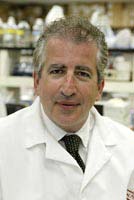Late invasion of infected cells into the brain causes HIV dementia say Temple researchers

Jay Rappaport, professor of biology in the Center for Neurovirology and Cancer Biology at Temple University.
Dementia in AIDS patients is caused by a large, late invasion of HIV-infected macrophages–large, long-lived cells of the immune system that travel throughout the body and ingest foreign antigens to protect against infection–into the brain, according to researchers at Temple University’s Center for Neurovirology and Cancer Biology (http://www.temple.edu/cnvcb/), debunking a longstanding “Trojan Horse” theory that early infection by macrophages remains latent until the latter stages of AIDS.
The results of their study, “Macrophage/Microglial Accumulation and Proliferating Cell Nuclear Antigen Expression in the Central Nervous System in Human Immunodeficiency Virus Encephalopathy,” was published in the June issue of the American Journal of Pathology [June 2004; Volume 164, Number 6] (http://ajp.amjpathol.org/). The study was funded by the National Institute of Neurodegenerative Disorder and Stroke and the Howard Hughes Medical Institute.
“Basically, one of the longstanding models for how HIV causes dementia is the ’Trojan Horse’ model,” says Jay Rappaport, Ph.D., a professor of biology at the Center, who led the study. “According to this model, early during HIV infection, there may be a few macrophages that are infected and get into the brain and establish an infection in the resident microglia [long-term resident macrophages of the brain]. Then, late in the disease, there’s a resurgence of the HIV virus from the macrophages.” Rappaport and his collaborators believe that this longstanding theory does not hold true, that the early invasion of HIV-infected macrophages are controlled and cleared away by the body’s immune system.
“Late during AIDS, which is when most HIV patients develop dementia, there is a second–or late–invasion of infected macrophages which is not a ’Trojan Horse’ but a ’Trojan Herd,’” says Rappaport. “It’s not just a few cells, but a huge number invading the brain.” Using markers, or antibodies, that can distinguish macrophages from resident microglia, the researchers were able to quantify the number of cells that appear to be macrophages and are producing the HIV virus.
“We found that there is about a 15- to 20-fold increase in the number of total macrophages in the brain during HIV dementia,” Rappaport says. “Why are there so many cells? We believe that the perivascular cells [macrophages around the blood vessels], as they invade further into the brain, adapt to their location and take on the functional characteristics of the resident migroglia. “They’re then activated and there are many more of them,” he adds.
Rappaport and his colleagues also looked at proliferation markers such as Ki67, but ruled out proliferation as being responsible for the increased number of infected cells.
“This study debunks the ’Trojan Horse’ model, it debunks the theory of a long latency in the brain by the infected cells,” concludes Rappaport. “It suggests that trafficking of the macrophages late in infection is really responsible for dementia in HIV patients.”
Rappaport has recently received a five-year, $2 million grant from the National Institutes of Health to continue exploring the trafficking of HIV-infected macrophages, not only in the brain, but in other organs of the body, and their role in the development of dementia in AIDS patients.
Media Contact
All latest news from the category: Life Sciences and Chemistry
Articles and reports from the Life Sciences and chemistry area deal with applied and basic research into modern biology, chemistry and human medicine.
Valuable information can be found on a range of life sciences fields including bacteriology, biochemistry, bionics, bioinformatics, biophysics, biotechnology, genetics, geobotany, human biology, marine biology, microbiology, molecular biology, cellular biology, zoology, bioinorganic chemistry, microchemistry and environmental chemistry.
Newest articles

Recovering phosphorus from sewage sludge ash
Chemical and heat treatment of sewage sludge can recover phosphorus in a process that could help address the problem of diminishing supplies of phosphorus ores. Valuable supplies of phosphorus could…

Efficient, sustainable and cost-effective hybrid energy storage system for modern power grids
EU project HyFlow: Over three years of research, the consortium of the EU project HyFlow has successfully developed a highly efficient, sustainable, and cost-effective hybrid energy storage system (HESS) that…

After 25 years, researchers uncover genetic cause of rare neurological disease
Some families call it a trial of faith. Others just call it a curse. The progressive neurological disease known as spinocerebellar ataxia 4 (SCA4) is a rare condition, but its…





















